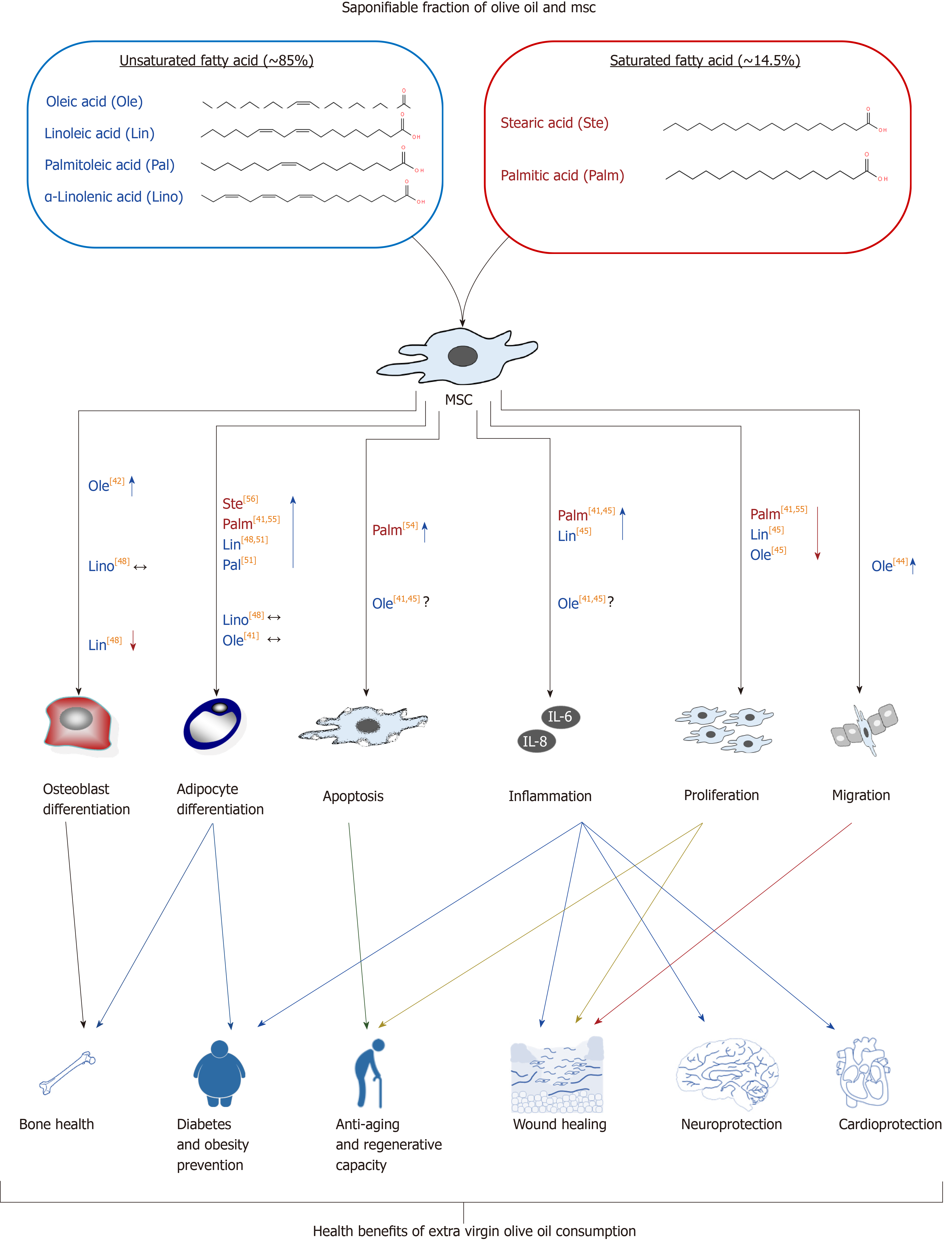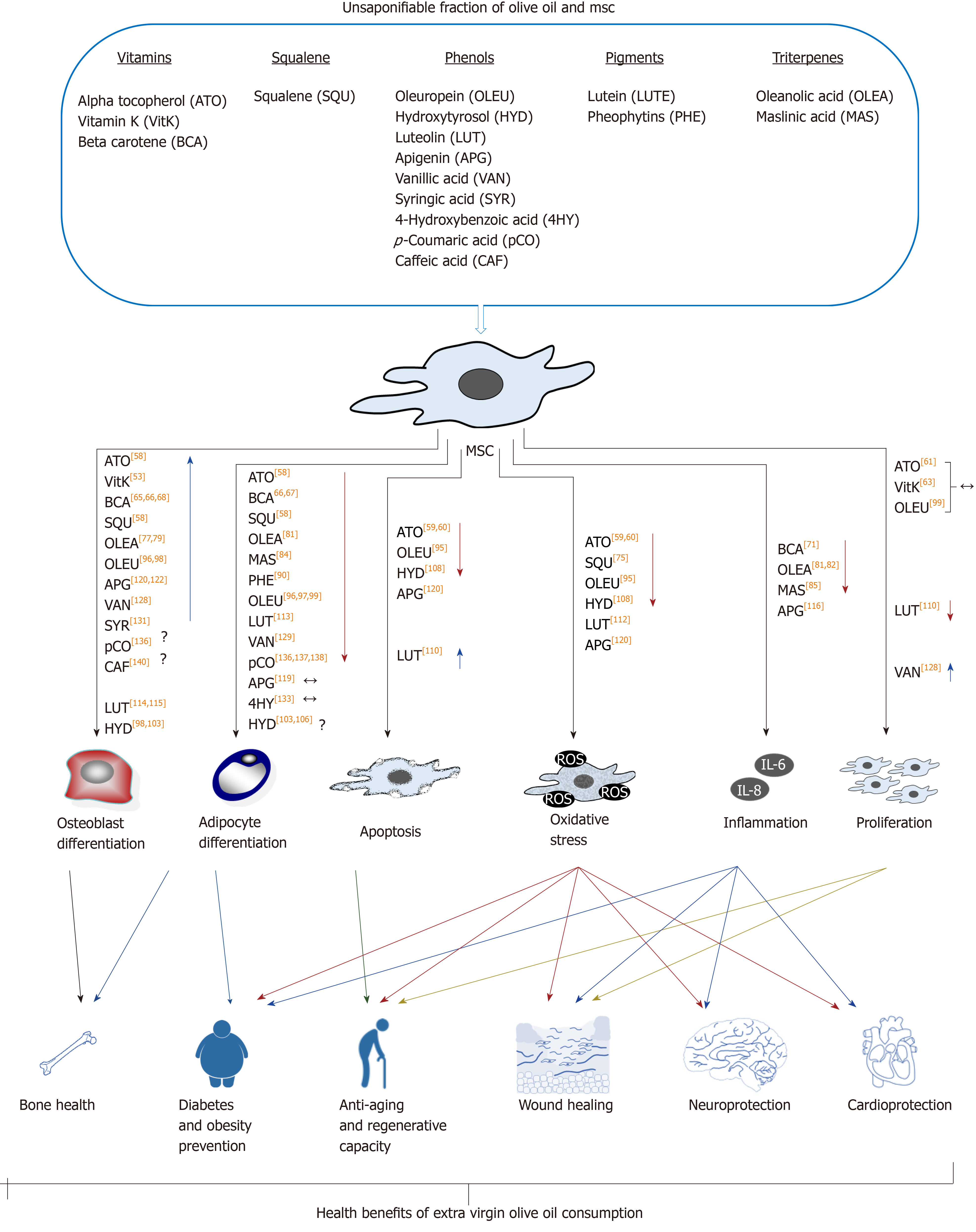Copyright
©The Author(s) 2019.
World J Stem Cells. Dec 26, 2019; 11(12): 1045-1064
Published online Dec 26, 2019. doi: 10.4252/wjsc.v11.i12.1045
Published online Dec 26, 2019. doi: 10.4252/wjsc.v11.i12.1045
Figure 1 Effects of extra virgin olive oil on health and mesenchymal stem cells.
Consumption of extra virgin olive oil has relevant health benefits, preventing cardiovascular and neurological pathologies, diabetes, and some types of cancer, and attenuating degenerative processes associated with aging, like osteoporosis, among others. Some of these healthy properties may be due to the modulation of biochemical pathways and positive effects of the constituents of this food on MSC populations. All that may have positive consequences for other cells, tissues, organs, and the whole organism. MSCs: Mesenchymal stem cells.
Figure 2 Effects of saponifiable fraction of olive oil on mesenchymal stem cells.
Unsaturated fatty acid residues present in olive oil have effects on several biological activities of mesenchymal stem cells (MSCs), including differentiation, proliferation, inflammation, migration, and apoptosis, among others. Such effects can be related to different aspects of human health, being modulated by olive oil consumption. They include better bone health, less incidence of diabetes and obesity, and better regenerative, neurological and cardiovascular capacities, among others. Several residues of fatty acids studied (other than oleic acid) may increase adipogenesis and inflammation, inhibiting MSC proliferation. Fortunately, oleic acid accounts for the highest percentage (55% to 83%) of total fatty acid residues of olive oil. Therefore, its positive effects prevail after olive oil intake. Among others, they include increase of osteoblastogenesis and MSC migration, not affecting adipogenesis, apoptosis or inflammatory status. Symbols: ↑ and ↓ represent increase or reduction of effect, respectively, due to involved fatty acid residues; The ↔ indicates that the studies carried out so far have not found significant effects on the evaluated parameter; The ? indicates contradictory data. The numbers in square brackets indicate the bibliographical references. MSCs: Mesenchymal stem cells.
Figure 3 Effects of unsaponifiable fraction of olive oil on mesenchymal stem cells.
The different groups of compounds included in the unsaponifiable fraction of olive oil have positive effects on mesenchymal stem cells (MSCs). Among others, they include differentiation, proliferation and inflammation capacities, reducing oxidative stress and apoptosis. These effects may be related to different aspects of human health, which are positively influenced by consumption of this food. Among others, they involve better bone health, lower incidence of diabetes and obesity, and better regenerative, neurological and cardiovascular capacities. In general, available data show that the studied compounds present in olive oil enhance bone vs fat formation. They also reduce apoptosis, oxidative stress, and inflammatory status of MSCs. All that may have a positive impact on health, explaining at least partially the beneficial effects of olive oil consumption. Symbols: ↑ and ↓ represent increase or reduction of effect, respectively, due to involved fatty acid residues; The ↔ indicates that the studies carried out so far have not found significant effects on the evaluated parameter; The ? indicates contradictory data. The numbers in square brackets indicate the bibliographical references. MSCs: Mesenchymal stem cells; ATO: Alpha tocopherol; VitK: Vitamin K; BCA: Beta carotene; SQU: Squalene; OLEU: Oleuropein; HYD: Hydroxytyrosol; LUT: Luteolin; APG: Apigenin; VAN: Vanillic acid; SYR: Syringic acid; 4HY: 4-Hydroxybenzoic acid; pCO: p-Coumaric acid; CAF: Caffeic acid; LUTE: Lutein; PHE: Pheophytins; OLEA: Oleanolic acid; MAS: Maslinic acid.
- Citation: Casado-Díaz A, Dorado G, Quesada-Gómez JM. Influence of olive oil and its components on mesenchymal stem cell biology. World J Stem Cells 2019; 11(12): 1045-1064
- URL: https://www.wjgnet.com/1948-0210/full/v11/i12/1045.htm
- DOI: https://dx.doi.org/10.4252/wjsc.v11.i12.1045















